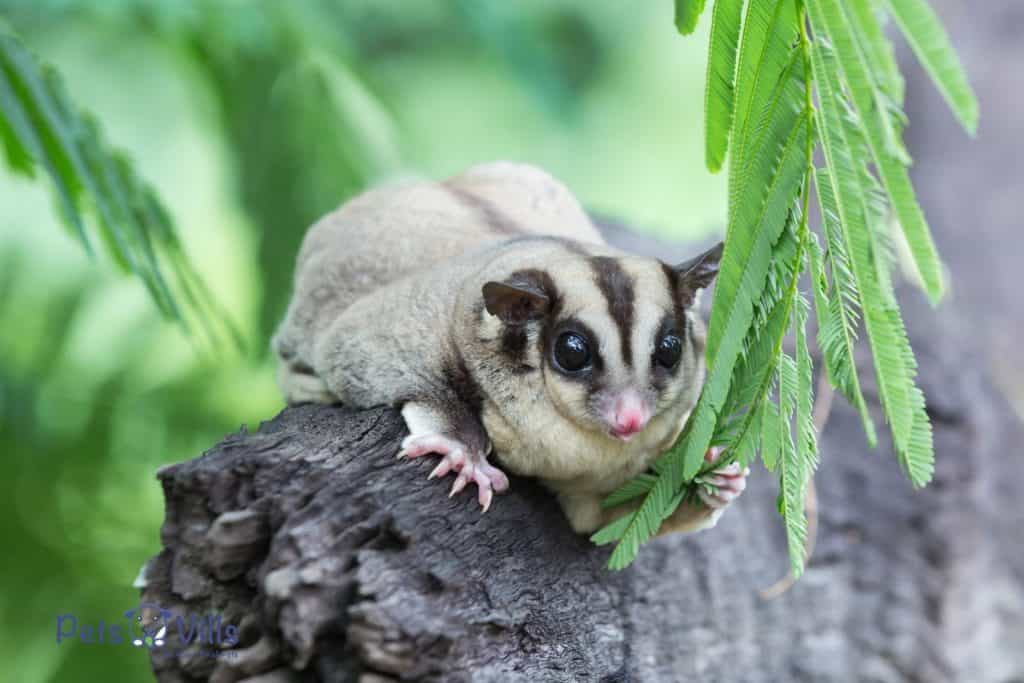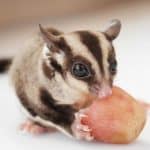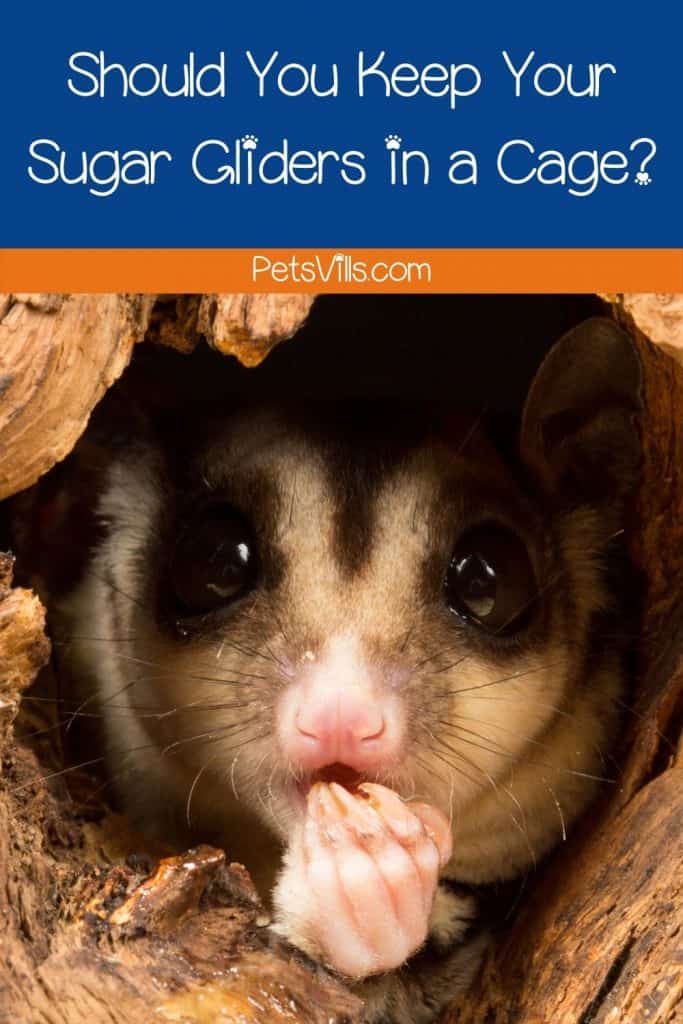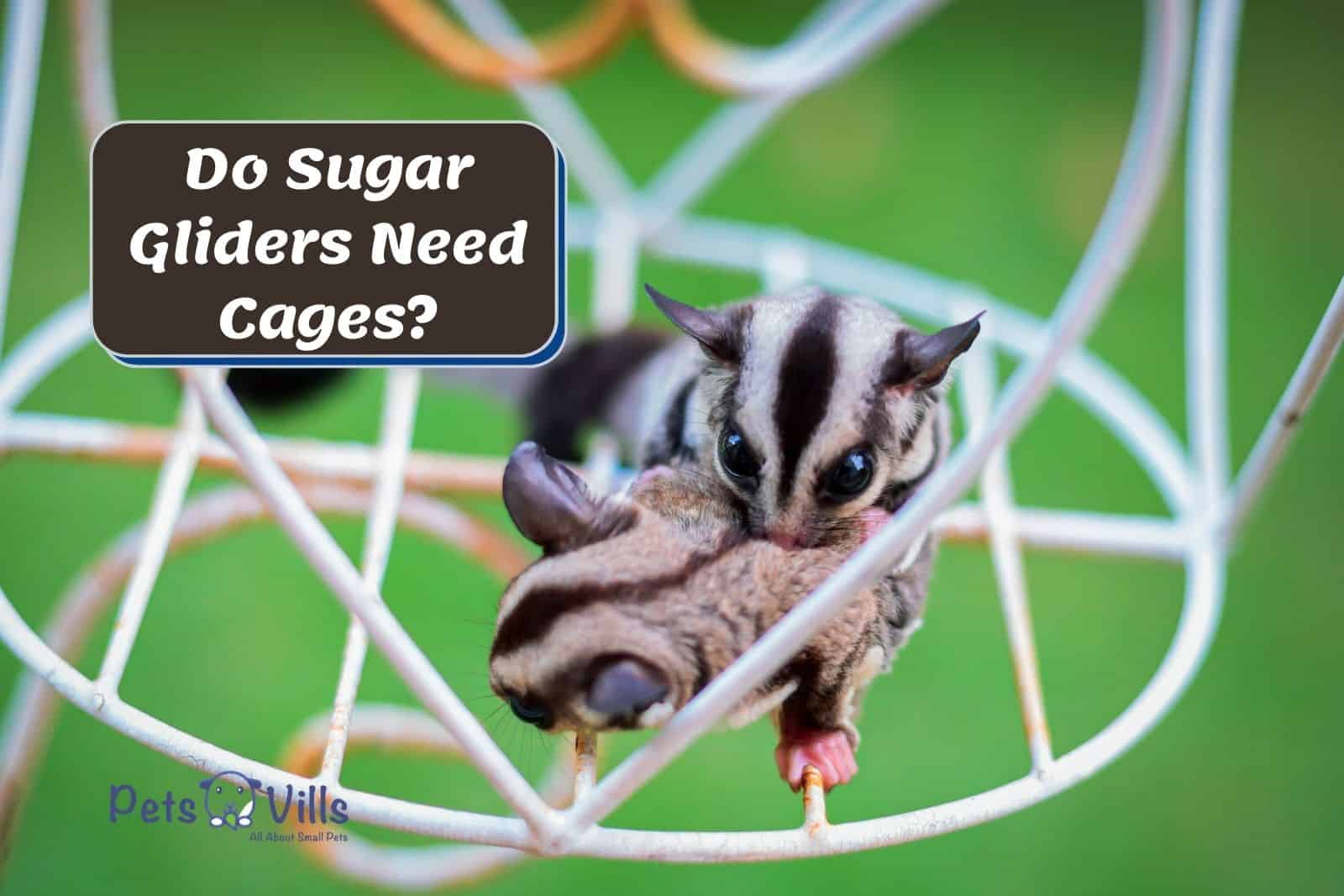Do sugar gliders need a cage?
An important question you need to know if you are thinking of getting one of these social animals as a pet.
Here I will discuss the positives of having a cage and the environment you need to create if you don’t want to keep them in one.
Keep reading to learn everything you need to know to get started.
Table of Contents
Do You Really Need to Get a Cage for Your Sugar Glider?
A cage with plenty of space and attractive accessories is the best way to keep them. The sugar glider cage bar spacing will ensure your furry friend has a safe environment.
But do sugar gliders need a cage or not? Can you create a home for them without one?
Since gliders are small animals it is easy for them to escape when they are unrestricted. This can put them in danger. Even the smallest things in your home can pose a risk to sugar gliders.
Not only does the cage protect them, but it also makes it easier as a glider parent to look after them and monitor their health.
The larger the cage the better. It will provide plenty of space for your little friend to move and fill with stimulating accessories. Also, since gliders are nocturnal animals, the best cage for sugar gliders will give them a sense of consistency and security.
You also want to make sure the cage has plenty of verticle space as these adorable fur babies love to climb.
The American Veterinary Hospital (1) recommends that “you’ll need a cage that is at least 3’ x 2’ but get the biggest one you can. Be sure the bars are less than a half-inch apart, so your pets can’t get stuck.”
Can a Sugar Glider Live Without a Cage?

Pet gliders can live without a cage, but safety is paramount. They will also require a large space that stays at the right temperature and has plenty of nooks for them to hide in.
Most people don’t have the space to create a large space like this that is still safe for gliders, so only consider it if you have the right environment.
What is Best For Sugar Gliders – With or Without a Cage?
Since gliders are wild animals that have become popular pets. In the wild, they can happily live freely in the right environment with a good supply of food. They like to nest in the hollows of tree trunks and rarely nest alone. (5)
However, in a home environment, it is not possible to keep them without a cage. Many people create large enclosures or have a ‘glider room’.
Having a glider room is a great way to give your pet more room, so long as it is 100 percent glider proof!
How To Keep Sugar Gliders In a Cage?

Pet gliders should be kept in a cage but there are some essential things you need to know. As the vet I quoted above says, they need to live in a cage that has a lot of space to roam around in.
If your environment does not provide enough exercise, gliders can suffer from health issues, including stress, depression, heart, and liver disease. (6)
You also need to provide nutritious food, toys for entertainment, and equipment for exercise.
Here are some great tips and advice I’ve learned over the years from experts and experienced glider parents to keep your pet healthy and happy.
- They require extra care and attention. Don’t slack on cage hygiene, stimulation, and love.
- They need an ample amount of space to live in but is secure enough that they can’t escape or injure themselves
- They have a specific diet that needs to be followed strictly which includes fresh fruit, sweet potato, and other sugary foods that they like. However, don’t overdo it on the sugary foods as it can lead to obesity.
- They can easily get injured or harmed, so safety is essential.
- You must clean their cage often to prevent health problems.
- Keep the cage in a glider-appropriate location. Long Island Bird & Exotics Veterinary Clinic states that the cage should be kept away from direct sunlight, in a place that is easy to access, away from doorways, vents, windows, heaters, and air conditioners. (3)
- Keep all the essentials within the cage to make it more welcoming. Essentials include toys, nest boxes, bedding material, wood shavings, food bowls and water dishes, exercise wheels, and ropes.
The advice I’ve highlighted above is just some of the basic reasons gliders should be kept in a cage.
To learn what accessories are safe to put in your glider’s cage take a look at this video.
But does this really keep them happy? That’s a hard question to answer, but I will touch on that next.
Do Sugar Gliders Like Cages?
It is hard to give a definitive answer to this, as each glider has its own personality, and preferences, and will live in slightly different environments.
However, as their protector and parent, it is important that you take responsibility for creating a home where they feel comfortable and that caters to all their needs, including a proper diet.
This is the best way to ensure they like their cage.
RELATED ARTICLE: Used Sugar Glider Cages for Sale
Should Sugar Gliders Be Kept Alone?
Now that you know why you should keep your furry family member in a cage and what you need to do to provide them with one that makes them happy, let’s tackle another important aspect of their well-being.
Should sugar gliders be kept alone? The answer is no, due to the nature of these animals.
In nature, gliders live in a highly interactive colony. It is strongly recommended to purchase and keep them in pairs to provide them with companionship and comfort.
Veterinarians from the VCA animal hospital state that “They should not be kept as single pets.” (4)
However, there are a couple of rules you should follow. Multiple males should not be kept with one female glider as they might try to show dominance and fight with the female glider.
New gliders should be kept away from each other as they might exhibit aggressive behavior if kept together.
Take a look at this expert glider owner to learn more about why they should not be kept alone.
FAQs
What should I put in my sugar glider cage?
Fit out your sugar glider’s cage with bird toys, water bottles, bedding material, an exercise wheel, a food dish, and other safe accessories.
Does a sugar glider make a good pet?
Yes, they are great pets for those who love animals and are willing to learn about taking care of their needs.
Is it cruel to keep a sugar glider as a pet?

No, it is not cruel to keep sugar gliders as a pet as long as you take care of their needs and keep them safe and healthy. (2)
Do sugar gliders bite?
Yes, sugar gliders can bite if they are scared, practicing self-defense, or if they notice an unfamiliar smell.
Conclusion
Sugar gliders are small, furry, nocturnal animals that are native to Australia. They live in trees, and they have a fondness for sweet foods. They can be kept happy as pets but under certain conditions that I’ve covered here in my guide.
One of these main conditions is the question – do sugar gliders need a cage? In a domestic home environment, the best answer is yes! If you want a long, happy, and safe relationship with your pet, you must prioritize their needs.

Did you or did you not put your sugar glider in a cage? Tell us your experience in the comment section below!
References
- (1) “Caring for a Sugar Glider.” American Veterinary Hospital, 14 Feb. 2018, americanvethospital.com/caring-sugar-glider. Accessed 3 Apr. 2022.
- (2) Di Qual, Adrian. The Suitability of Sugar Gliders (Petaurus Breviceps) as Domestic Companions: An Analysis of Survey Data. 2013.
- (3) “Sugar Glider Care Guide | Long Island Exotic Pet Vet.” Libirdexoticsvet, www.birdexoticsvet.com/sugar-glider-care-guide.
- (4) “Sugar Gliders – Owning.” Vca_corporate, 2009, vcahospitals.com/know-your-pet/sugar-gliders-owning.
- (5) Jirik, Kate. “LibGuides: Sugar Glider (Petaurus Breviceps) Fact Sheet: Behavior & Ecology.” Ielc.libguides.com, ielc.libguides.com/sdzg/factsheets/sugarglider/behavior.
- (6) “Disorders and Diseases of Sugar Gliders – All Other Pets.” Veterinary Manual, www.msdvetmanual.com/all-other-pets/sugar-gliders/disorders-and-diseases-of-sugar-gliders.
Alina Hartley is a small-town girl with a ginormous love of bearded dragons. It all started with Winchester, a baby bearded who was abandoned at the shelter by his former owners because of a birth defect that caused one front leg to be shorter than the other. Alina originally went to the shelter looking for a guinea pig, but one look at Winchester and it was love at first sight. From that day on, Alina has dedicated her life to learning everything she can about bearded dragons. She loves helping new beardie parents start their incredible journey with these magnificent reptiles.
Follow her on:
LINKEDIN
TWITTER.
Read her latest articles HERE
Learn more about her HERE.




![Cute Sugar Glider Drinking From The Bottle [Must-Watch Video]](https://petsvills.com/wp-content/uploads/2022/09/Cute-Sugar-Glider-Drinking-From-The-Bottle-Must-Watch-Video-211x150.jpg)
